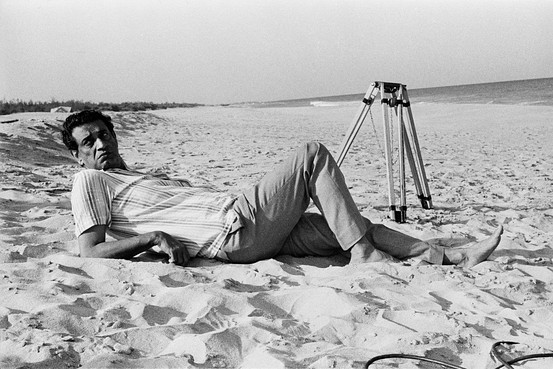Going back to Ray
Published @ Daily News & Analysis
To view the published version, see
Daily News & Analysis

Satyajit Ray, by Nemai Ghosh. Image under copyright.
The idea of commercially re-releasing three of Satyajit Ray’s films by Sony Pictures is an inspired idea. Ray remains, despite Bollywood’s repeated efforts to ‘showcase’ itself in respectable film venues like Cannes and Venice — the most enduring icon of Indian cinema. The release, thankfully, does not include the umpteenth rerun of his Apu Trilogy, for which he is feted the world over. The films being screened were made between 1968 and 1970 and belong to a different stage of his filmmaking career, encompassing some of his vital concerns as an artist.
As a fantasy film for children, Goopy Gyne Bagha Byne (The Adventures of Goopy and Bagha) is perhaps the most brilliant anti-war parable ever filmed. Made during the height of anti-Vietnam War protests, it is about two innocent musicians who manage to win over the King of Ghosts and receive three gifts — of unchained melody, unrationed food and limitless travel. They land up in Shundi, a kingdom ruled by a pacifist king whose kingdom is under siege, for no apparent reason, from his brother’s kingdom Halla. Goopy and Bagha visit Halla’s king, who they find is a childlike figure kept enthralled in a Machiavellian delirium by his minister with the aid of his scientist. Forget Vietnam, the parallels with the Iraq war are uncanny.
Ray adapted Aranyer Din Ratri (Days and Nights in the Forest) from a Sunil Gangopadhay novel about four friends who, in a moment of revelation, leave their home in the city to seek temporary liberation in the forests of Palamau. They get to meet tourists and locals in their trail towards impetuous self-discovery. What follows is a complex and multifaceted exploration of class, habits, social mores and sexuality. In a famous scene, the principal characters play memory game; each name and each round of names underlying the tensions that flow through their complex interplay.
Pratidwandi (The Adversary), considered part of Ray’s Calcutta trilogy (with Seemabaddha (Company Limited) and Jana Aranya (The Middleman), is new-wave cinema at its most brutal. The chaos of early ‘70s Calcutta is palpable — a time when rhetoric was effusive and hope was deficient. Siddartha learns the same, when he fails a job interview after retorting that the most decisive event of the preceding decade was not man’s landing on the moon, but the Vietnam war. His brother, a dedicated Naxal, is the radical counterpoint to Siddartha’s hesitant humanity and his quest to live with ordinary means in extraordinary times.
Try and see all three of them. You might want to go back to serious, meaningful, cinema all over again.
comments for this post are closed